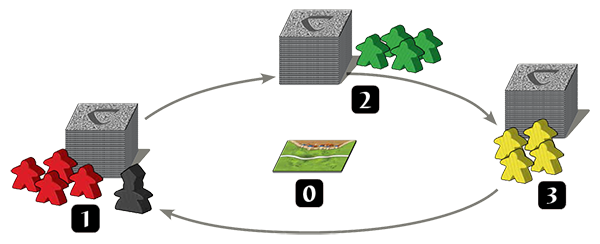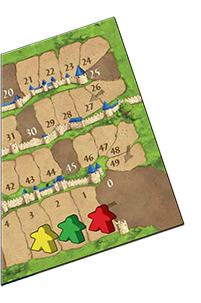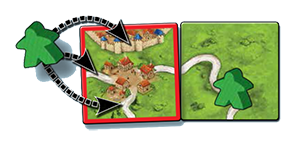Solo Variant
Algemene informatie en opmerkingen
De Solo Variant is uitgegeven door Hans im Glück in Template:Year nl.
Het is een variant voor één enkele speler, maar het kan ook als team-uitdaging gespeeld worden.
Speelmateriaal
Om deze solo variant te spelen, heb je de Carcassonne base game nodig. Gebruik de volgende:
- 72 landtegels inclusief de starttegel.
- 5 gewone meeples" in 3 kleuren.
- 1 abt in een vierde kleur (optioneel).
- 1 scorebord
Spelregels
Voorbereiding
Kies 3 kleuren en zet 4 meeples opzij. Elke beurt speel je met een andere kleur met de klok mee, dus om niet in de war te raken wat betreft de beurtvolgorde, bereid je je als volgt voor:
- Zet alle pionnen van de ene kleur links, die van een andere kleur in het midden en de meeple van de derde kleur. rechts. Plaats een stapel [1] van 1/3 van alle geschudde tegels met de beeldzijde naar beneden naast elke pionkleur (1e en 2e stapel met elk 24 tegels, 3e stapel met 23 tegels).
- Optie: Neem een abt (in een kleur die je nog niet gekozen hebt) en zet deze naast de kleur waarmee je wilt beginnen. Na elke beurt gaat de abt met de klok mee naar de volgende kleur en laat je zien welke kleur je deze beurt moet gebruiken. Omdat sommige beurten, met een puntentelling, langer kunnen duren en je misschien de punten voor meerdere kleuren moet tellen, kan dit je helpen het overzicht te behouden.
- Ga verder door nog een meeple te nemen [2] van elk van de drie kleuren uit de doos om te gebruiken op het scorebord. Het meeple van de eerste kleur wordt op veld 1 geplaatst, dat van de tweede kleur op veld 2 en dat van de derde kleur op veld 3. [3]
Gameplay en doel van het spel
Elke beurt speelt u afwisselend met een van de drie kleuren en probeert u zoveel mogelijk punten te scoren. Blijf de hieronder beschreven werkwijze volgen met elke kleur elke beurt, totdat het spel is afgelopen. Aan het eind van het spel worden echter alleen de punten geteld van de kleur die als laatste op het scorebord staat. Daarom moet je proberen om de punten gelijkmatig te verdelen over elke kleur.
1. Placing a tile
Draw the top tile from the stack of the color being used this turn and place it according to the usual rules.
2. Placing a meeple
After having placed the tile, place a meeple of the respective color. As opposed to the usual rules, you must place a meeple, if it is possible.
Hence if there is a free feature on your tile, you must place a meeple on it.
If there is more than one free feature on the tile, you can decide which one you want to place the meeple on.
However, a meeple can never be placed as a farmer.
Attention: If you have to place a meeple, because there is a free feature on the tile, but do not have any meeples of the respective color left, the game ends (after a possible scoring).
3. Scoring a feature
If you have completed a feature with a tile, score it.
- If there are only meeples of one color present in a completed feature, the points are only scored by this color if it is the one with the least number of points on the scoreboard.
- If two or more colors make up the majority in a completed feature, all of them score points if at least one of the colors was last on the scoreboard (before this scoring).
| Scoring summary | |
| Feature | Scoring |
|---|---|
| Road | 1 point / tile |
| City | 2 points / tile 2 points / coat of arms |
| Monastery | 9 points |
More than one color on the same lowest space on the scoreboard: In both cases, this also applies if two colors have the least number of points (before the scoring) and also if all colors have the same number of points.
If you complete more than one feature in a turn, each of them is scored separately, one after another and according to the abovementioned rules. You can decide in which order you score them.

Tip: You may also complete features if the meeple color does not have the least number of points on the scoreboard. In this case you do not receive points but get your meeple back. This can be important to prevent the end of the game.
Game end and final scoring
The game ends either after a turn in which you:
A) Have to place a meeple, but cannot
OR
B) Have placed the last tile.
The usual final scoring is omitted in both cases. Instead, this final scoring is conducted: You receive 2 points per meeple on tiles. However, those points can only be scored if the respective color of the meeple has the least number of points on the scoreboard. Here you can also decide in which order you want to conduct the scoring.
Options
If you find this solo mode too hard or too easy, try these options:
- It gets easier if you take more meeples of each color.
- You can also try adding another color with 4 meeples. This will make it easier to place more tiles (and score more points), but also more challenging to keep track and plan ahead.
- You can also try to use just 3 meeples per color, let’s see how that works out.
- Of course you can add all sorts of meeples and tiles from other expansions, if you can stick it out.
- Adding special meeples and tiles is also possible, however, we haven’t tried it yet, so you’d have to try that at your own risk!
Goals
You can check if you completed any these goals during a game.
- Scoring a road worth at least 10 points
- Scoring a road worth at least 10 points and 2 colours
- Scoring a road worth at least 10 points and 3 colours
- Scoring a road worth exactly 5 points with 3 colours
- Scoring a city worth at least 16 points
- Scoring a city worth at least 16 points with 2 colours
- Scoring a city worth at least 16 points with 3 colours
- Scoring a city worth 8-10 points with 3 colours
- Scoring 3 monasteries (9 points each)
- Scoring 4 monasteries (9 points each)
- Total scoring of at least 40 points
- Total scoring of at least 50 points
- Total scoring of at least 60 points
- Having used all tiles
Voetnoten
Ga voor licentie en uitleg over de pictogrammen naar de pictogrammen pagina.
- ↑
 De regels van HiG gebruikten het woord " pile" In het Engels. In plaats daarvan hebben we "stack" gebruikt omwille van de duidelijkheid met andere regels in het Engels. Wij gebruiken het woord stapel.
De regels van HiG gebruikten het woord " pile" In het Engels. In plaats daarvan hebben we "stack" gebruikt omwille van de duidelijkheid met andere regels in het Engels. Wij gebruiken het woord stapel.
- ↑
 Deze meeple komt uit de doos, niet uit de set van 4 meeples die al apart staan.
Deze meeple komt uit de doos, niet uit de set van 4 meeples die al apart staan.
- ↑
 Wij gebruiken het woord " space " omwille van de consistentie met andere Engelse regels. De versie van HiG gebruikte het woord "field" in plaats daarvan. Wij spreken over een "Veld"
Wij gebruiken het woord " space " omwille van de consistentie met andere Engelse regels. De versie van HiG gebruikte het woord "field" in plaats daarvan. Wij spreken over een "Veld"








